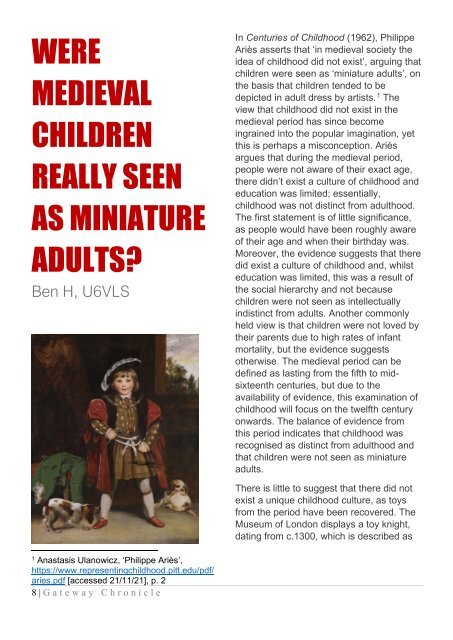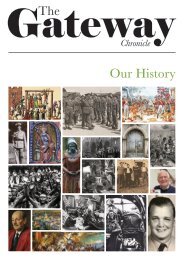Gateway Chronicle 2022
You also want an ePaper? Increase the reach of your titles
YUMPU automatically turns print PDFs into web optimized ePapers that Google loves.
WERE<br />
MEDIEVAL<br />
CHILDREN<br />
REALLY SEEN<br />
AS MINIATURE<br />
ADULTS?<br />
Ben H, U6VLS<br />
In Centuries of Childhood (1962), Philippe<br />
Ariѐs asserts that ‘in medieval society the<br />
idea of childhood did not exist’, arguing that<br />
children were seen as ‘miniature adults’, on<br />
the basis that children tended to be<br />
depicted in adult dress by artists. 1 The<br />
view that childhood did not exist in the<br />
medieval period has since become<br />
ingrained into the popular imagination, yet<br />
this is perhaps a misconception. Ariѐs<br />
argues that during the medieval period,<br />
people were not aware of their exact age,<br />
there didn’t exist a culture of childhood and<br />
education was limited; essentially,<br />
childhood was not distinct from adulthood.<br />
The first statement is of little significance,<br />
as people would have been roughly aware<br />
of their age and when their birthday was.<br />
Moreover, the evidence suggests that there<br />
did exist a culture of childhood and, whilst<br />
education was limited, this was a result of<br />
the social hierarchy and not because<br />
children were not seen as intellectually<br />
indistinct from adults. Another commonly<br />
held view is that children were not loved by<br />
their parents due to high rates of infant<br />
mortality, but the evidence suggests<br />
otherwise. The medieval period can be<br />
defined as lasting from the fifth to midsixteenth<br />
centuries, but due to the<br />
availability of evidence, this examination of<br />
childhood will focus on the twelfth century<br />
onwards. The balance of evidence from<br />
this period indicates that childhood was<br />
recognised as distinct from adulthood and<br />
that children were not seen as miniature<br />
adults.<br />
There is little to suggest that there did not<br />
exist a unique childhood culture, as toys<br />
from the period have been recovered. The<br />
Museum of London displays a toy knight,<br />
dating from c.1300, which is described as<br />
1<br />
Anastasis Ulanowicz, ‘Philippe Ariѐs’,<br />
https://www.representingchildhood.pitt.edu/pdf/<br />
aries.pdf [accessed 21/11/21], p. 2<br />
8 | <strong>Gateway</strong> <strong>Chronicle</strong>


















